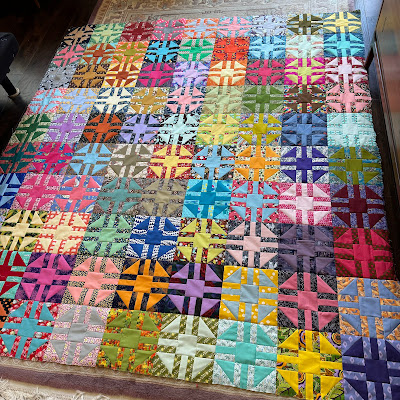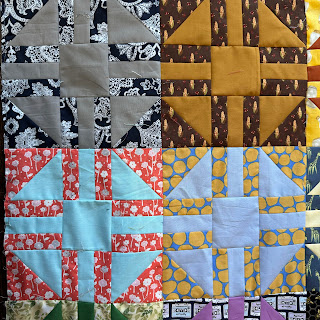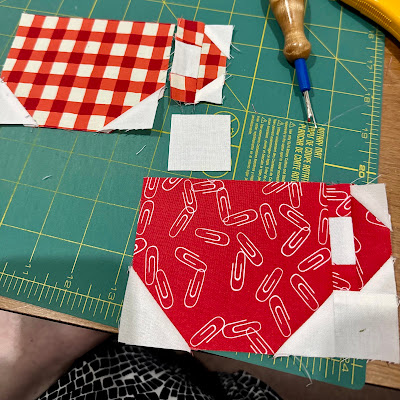

Little red Scottie dogs
Pieced dog measures 6 by 5 inches finished.
With frame finishes 8 by 7 inches.
NOTE:I did NOT frame my blocks for my quilt this way.
I was not sure what I would do with these blocks so I put a frame on only one to get an idea of what the finished block looks like.
I needed a calming and distracting activity on election day, so I decided to put one of my many Scottie Dog sketches to fabric. I've played with different proportions and construction techniques for a few years. There are many variations of the pieced Scottie. Here are the directions for my method, using the Easy Angle or Bonnie Hunter's essential triangle tool and Doug Leko's simple folded corner tool--mini size.

Cutting
White background (I used Kona Snow):
One rectangle 2 1/2 inches by 5 1/2 inches
One square 2 1/2 inches
Two rectangles 1 1/2 by 2 1/2 inches
Two triangles cut from 1 1/2 inch strip using the Easy Angle or Bonnie Hunter's essential tool.
(((Frames: Cut two 1 1/2 by 5 1/2 inch rectangles, two 1 1/2 by 8 1/2 inch rectangles)))
Red scraps
One rectangle 2 1/2 by 4 1/2 inches
One 2 1/2 inch square
Four 1 1/2 inch squares
Three triangles cut from 1 1/2 inch strip using the Easy Angle or Bonnie Hunter's essential tool.


First piecing
Sew two red triangles to two white triangles, press one to the red and one to the white.
Sew two red squares onto ends of a white 1 1/2 by 2 1/2 inch rectangle
Press to the squares.

Time for the Doug Leko ruler! I love this ruler and use it often.
On the large white rectangle, place a small red square on the left side and larger square on the right. Use the angle to trim off the outer triangles and sew these seams. Press towards the triangles.
On a small rectangle place a small red square and use the tool to trim the left upper side.
With the small triangle square that is pressed to the red, use the tool to one side as shown. Scroll down to see how I did these in groups to be more efficient with these fiddly pieces.
There is only one in the block so it works well to do them in batches.
NOTE: all these pieces will be in a different orientation in the block.

I did these in groups to be more efficient with these fiddly pieces. There is only one in the block so it works well to do them in batches.
Sew a red half-square triangle to these pieces and press away from the white.

Lay out all piece for block as shown.
Sew the small rectangle piece to the large rectangle keeping the ear and tail pointing up and upper face down. Press towards the ear.
Sew the fiddly piece onto the remaining pieced half square triangle--the opposing pressed seams nest nicely.
Press away from the fiddly piece.
Sew onto the white square. Press towards the white square.
Sew red body rectangle onto the legs. Press to the body.
Sew these two units together, press towards the body and legs.
Sew the top to the bottom, pressing towards the bottom.
Everything nests!
More process photos below.
My construction directions for a traditional block.
Use at your pleasure.
 |
| major units piece (back with pressing visible) |
 |
| ready for final seam |
 |
| final block pressing |
 |
| 14 dogs made before midnight |







































